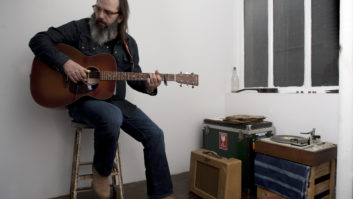
Sometimes, a so-called “career record” can affect more
than one career. When Arlo Guthrie’s cover of the late Steve Goodman’s
paean to America’s fading railroads, “City of New Orleans,”
came out as the single from Guthrie’s Hobo’s Lullaby LP in 1972,
it gave the folk-singing son of America’s own hobo poet laureate, Woody
Guthrie, his first bona fide chart hit. Arlo had already become known
for his cult classic, talking-blues epic about draft-dodging,
Alice’s Restaurant, which launched his recording career in 1967.
And his drug-joke tune “Comin’ Into Los Angeles” in 1969
showed that Guthrie could straddle both the rock and the folk idioms.
But “City of New Orleans” left the adolescent humor of both
of those earlier tracks behind, giving Guthrie a song for the ages
rather than of the moment.

It also was a turning point for Lenny Waronker, who, in 1972, was in
the midst of building multiple careers: as an A&R man at
Warner/Reprise Records, where he signed Little Feat, Rod Stewart and
Curtis Mayfield, among others; and as a producer, where he handled the
likes of the Doobie Brothers, Maria Muldaur and Rickie Lee Jones, among
others. But Waronker credits “City of New Orleans” with
making him a better record producer. “That was the record that
taught me to get the hell out of the way of the song,” states
Waronker, now a partner at the DreamWorks SKG label. “If you have
a great song, let it be. Learn when to let it be itself.”

Read more “Classic Tracks”
Buy the book
“City of New Orleans” was recorded, along with a few
other tracks from Hobo’s Lullaby, at Amigo Studios, a North
Hollywood facility owned at the time by Warner Bros. Records. Waronker
had helmed Guthrie’s previous LP, which spawned “Comin’ Into Los
Angeles,” and the producer understood the depth of Guthrie’s
desire to establish himself as a rock artist. “He wanted to
separate himself from the family [folk-music] legacy, and that was
understandable at the time,” says Waronker, who, at the same
time, had a busy production schedule underway, producing records for
Gordon Lightfoot, Ry Cooder and Randy Newman.
The ace up Guthrie’s sleeve was a song he and co-producer/guitarist
John Pilla were holding by Steve Goodman, the esteemed Chicago
singer/songwriter and recording artist, who had already been diagnosed
with leukemia. Guthrie and Pilla recognized that “City of New
Orleans” was a special song and invited Waronker to hear it in a
concert Guthrie was playing in San Jose, Calif.
“The plane was late and I got to the concert just as Arlo
started playing the song,” Waronker remembers. “I didn’t
realize it was the song that they were talking about till they were
halfway through it, but you could easily recognize it as a very unique
and beautiful song. It was almost like watching a movie, it was so
cinematic. The three verses were a play in three acts, united by the
soaring chorus.” Guthrie had created a rock arrangement for the
song, which Waronker and Pilla were less enthusiastic about.
“John and I sensed the song being done in a sort of pop version
of a Johnny Cash approach,” he says.
The first tracks for Hobo’s Lullaby were recorded at Sun West
Studios in Hollywood, where Guthrie’s arrangement of “City of New
Orleans” was recorded along with several other tunes. Waronker
and Pilla continued to nudge Guthrie toward another less-aggressive
vision of the track, “but Arlo was adamant at the time,”
Waronker says. “He didn’t want it to be like Goodman’s own
version of the song, which was folkier, the kind of thing he was trying
to get away from. But Arlo also liked a good argument. He knew we were
trying to finesse him on the song to see it our way, and that just made
him dig in harder about it. He is a great guy with a big heart, but he
did like to take part in a benign conflict.”
On another session, this one at Amigo, hunched over the console that
was custom-built by engineers Lee Herschberg and Al McPherson, and
listening over the Westlake monitors, Waronker and Pilla saw their
chance. They had assembled a killer crew of musicians, including
Cooder, Burritos bassist Chris Ethridge, drummer Jim Keltner and Jim
Dickinson on piano. Toward the end of the evening, around midnight,
when fatigue was setting in and Guthrie’s resistance was a bit lower,
Waronker and Pilla prevailed, stressing that this particular crew of
players could get their idea of the song across.
They did. It was the simple, uncluttered and laid-back arrangement
that Waronker had envisioned, and Guthrie soon agreed. The problem,
however, was that take late in the night resulted in an even more
laid-back tempo. “We had rushed to get it done before it got too
late, but we didn’t really think it out in terms of tempo,”
Waronker recalls. “It was way too slow.”
So engineer Donn Landee, who had worked on many records with
Waronker, tweaked the multitrack deck’s VSO, speeding up the song at
least a semitone higher, just barely getting to a tempo that Waronker
thought would work. Because overdubs were done to the sped-up
multitrack, it meant that Guthrie’s vocal range was stretched and that
tunings for overdubs had to be done to the track which is always a
tricky business. The good news, though, was that the VSO’d track
covered up some of the rough edges of the late-night recording session;
Waronker says there’s still a guitar clam or two on the record. And as
it turned out, testing Guthrie’s vocal range worked positively,
bringing out new aspects of him as a singer. But most of all, Waronker
reports, it gave “City of New Orleans” its ultimate charm.
“It had a kind of rickety sound to it sped up,” he muses,
“like toy musicians were playing it. It was a technique we used
to use a lot; we used it all of the time with Harper’s Bizarre. It was
a way of tightening things up on a track and it smoothed out pitch
issues. But this time, we did it because it was a way around what was
becoming a depressing tempo. And we didn’t reach that conclusion the
first night; we were just so happy we got the track. It took us a
couple of days to realize and then admit that the tempo wasn’t where it
should be. So we sped it up for very different reasons than we had used
that technique for in the past. But we really got lucky, because it
gave the track the charm.”
Waronker and Pilla wanted to stay with the vibe of the accelerated
track so instead of strings, they had Nick DeCaro play accordion on it,
using a reedy register for the verses and a fuller, more mournful sound
on the choruses. The choruses also had a choral effect achieved by
triple-tracking singers Clydie King and Venetta Field, and then adding
stereo delay and reverb and double-tracking Guthrie, a technique that
the singer apparently was not fond of. “We wanted an angelic
sound, but not too much church,” Waronker explains. “So we
told them to back off on the vibrato, and we built up at least three
tracks of background vocals, plus Arlo’s vocals, and they really took
the chorus to another place.” Another aspect of the record was
the fact that overdubs were done in real time, in contrast to the
sped-up basic track; quite an effective juxtaposition it turned out to
be.
But it was during the overdub process that Waronker had his epiphany
about producing songs, not just artists. “There were a lot
of things we could have kept adding to the track,” he says.
“It was becoming so magical. We were all still young and still
learning how to make records. But I had this moment of clarity at one
point, and said, ‘That’s enough!’ It felt good, because I
had been having this internal battle about how far to take the track.
It felt good to let it go, and that’s when I realized about getting the
hell out of the way of the song. It’s a lesson I took with me from that
day on.”
“City of New Orleans” made it into the Top 20 in the
summer of 1972 and was ubiquitous on both AM and FM radio for months:
Everywhere, people seemed to be singing that impossibly catchy
chorus: “Good morning, America, how are you?/ Don’t you know me,
I’m your native son/ I’m the train they call the City of New
Orleans/I’ll be gone five hundred miles when the day is done.”
And though neither Guthrie nor Goodman ever scaled such heady
commercial heights again, they created a slice of Americana that has
become an undeniable classic, likely to be remembered decades from
now.

Arlo Guthrie’s “The City of new Orleans” was released in
1972. Although it never made it to Number One on the charts, it broke
the Top 20, peaking at number 18. Take a trip down memory lane with
this look back at the top hits of 1972..







